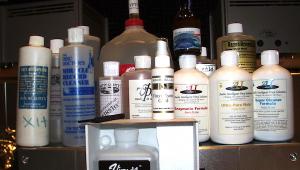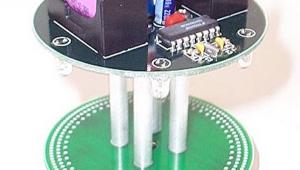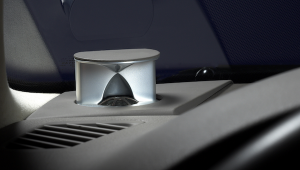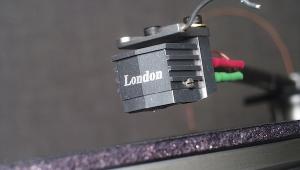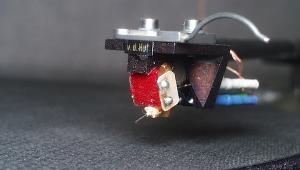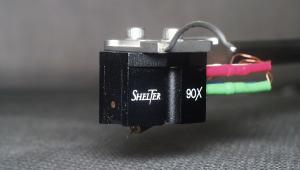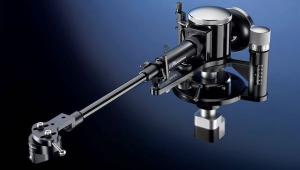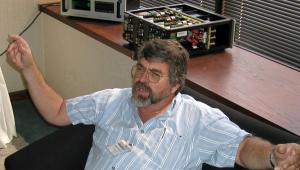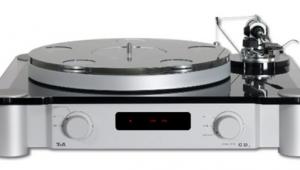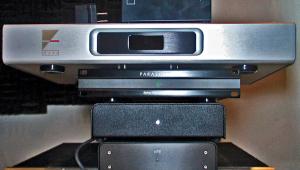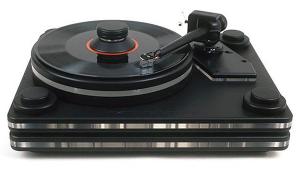Analog Corner #77
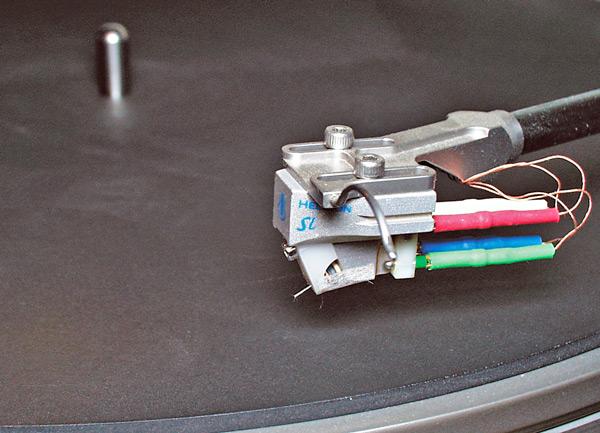
When my wife called from work to tell me she'd heard that a small plane had hit one of the World Trade Center towers, I was busy packing. I turned on CNN, kept packing, and saw the second plane hit as it happened. I unpacked. Even if Virgin was flying, I wasn't. As it turned out, nobody flew out of Newark that night.
I found it impossible to concentrate on anything but current events for at least a week after September 11. I occasionally slipped downstairs for some musical solace, but such listening could hardly be called "reviewing." It was more for peace of mind—and to get away from the TV. The stereo and my collection of music did not let me down: lots of Brahms, Bach, and, for some reason, Brian Eno. In one sitting, I played the entire four-LP boxed set of flipped the mental coin and got pissed, I cranked up The Clash and Led Zep to work off steam. I'll bet everyone reading this applied some reliable musical balm during those difficult days.
Because this column was supposed to be a show report, I'd used the first 10 days of September to concentrate on the Kora Cosmos monoblocks (reviewed elsewhere in this issue). I did most of my listening to the Kora Cosmoses with Hovland's built-in phono section, but I was sitting on a treasure trove of phono sections, which were supposed to be covered next month: the Pass Xono, Manley Steelhead, and Final Labs. But first an update:
Lyra Helikon SL moving-coil cartridge
The $2195 low-output (0.22mV) SL version of the Helikon shares the original's admirably neutral timbral balance (see "Analog Corner," August 2000), but significantly ups the ante in terms of low-level resolution, image size and focus, and, especially, soundstage width and depth. Good as the original Helikon was, the SL dramatically enhances the fineness of images while significantly increasing the expression of depth. The original Helikon sounded almost thick and congested by comparison, which is ridiculous—the original was a very detailed performer in its own right.
But in order to get the SL's benefits you must have a high-gain, low-noise phono section. Otherwise, noise will intrude and/or dynamics will suffer greatly, leaving you with limp, uninvolving sonics. One of the benefits of the original was its output (0.45mV), which was sufficient to mate well with a wide range of phono preamps. But if you didn't like the original Helikon—some vocal detractors thought it bleached harmonics—the SL will not make you change your mind.
Manley Steelhead tube MM/MC phono preamplifier
The Steelhead was first demonstrated at the 2001 Consumer Electronics Show. Nine months later, my long-promised review sample of Eveanna Manley's new baby was delivered. While Ms. Manley may have given birth to the audacious product, it was conceived by the company's chief hi-fi designer, Mitch Margolis.
The Steelhead is the most flexible, user-friendly phono section I've ever encountered. There are two moving-coil (MC) inputs on the rear panel, one with RCA jacks, the other a female DIN connector, should you desire to use a DIN-to-DIN cable for your Graham, SME, or other DIN-equipped arm. There's a single set of RCAs for the moving-magnet (MM) input. There are fixed and variable outputs, the latter associated with a front-mounted volume control and three ground lugs: one for the phono input cable, and a pair by the output jacks labeled Chassis and Circuit. Also on the back panel is one of those humongous multi-pin power-supply connectors.
The front panel's left side features a gain switch with four positions (50, 55, 60, and 65dB), which auto-mutes when you use it so that there are no speaker explosions; and a three-position input selector switch (MC1, MC2, MM). On the right side is a "big honkin' ;';' volume control (Manley website terminology for a Noble audiophile-quality pot) and four pushbuttons, labeled Standby, Sum, Dim, and Mute. Between those, a smaller "honkin' ;';' selector switch performs different functions, depending on whether you're using the MM or MC inputs. In MM, it allows you to select impedances of 25, 50, 100, 200 ohms, and 47k ohms. Why would you need those? Read on.
In MC mode, the switch controls a "variable-load auto tranny" (more Manley lingo), which is the steelhead transformer/autoformer that gives the preamp its name. The switch controls five taps on the proprietary "dual-primary, bifilar wound, high-bandwidth, low-resistance, and multiple-shielded nickel-core step-up autoformer," which allows you to choose among 25, 50, 100, 200, and 400 ohm settings. By impedance matching the cartridge with the step-up transformer, you can maximize power transfer. That means efficient, low-loss conversion of the ultra-low-voltage/high-current cartridge output to high voltage and low current. When you resistively load down an MC cartridge, you throw away power, which is why conventional loading tends to "close down" the sound as well as lowering the output—sometimes for the better, sometimes not. The front panel also includes switches that permit individual channel control of cartridge termination capacitance in 10pF steps up to 1100pF.
Design: The Steelhead looks like a piece of homely medical equipment from the 1950s. Call it drop-dead ugly, retro studio, or whatever—I don't think you could ever say that it looks "sleek" or "smart." Apparently, Manley is switching to a steel-colored faceplate (as seen on their website, www.manleylabs.com/containerpages/steelhead.html), which should help considerably. As delivered to me, with its gaudy gold front, large ice-blue LEDs, clunky black knobs, and backlit "Manley Steelhead" TV screen–like logo, it's about as attractive as a severed fish head.
An umbilical cord terminated with a gold-plated 16-pin connector provides juice from the heavy-duty regulated outboard multichannel power supply to the main unit, each channel supplied independently (hot and ground) via multi-core shielded interconnects. The RIAA and amplifier sections each use one 6922 and two 7044 tubes in their circuits. According to the very-well-written and extremely informative instructions, the circuit "makes the best use of active and passive components and circuit developments generated over the past half-century;';'—which, as I found out when I asked, is an elliptical way of saying without saying that there's a JFET in the first gain stage.
When I asked Eveanna Manley whether there was a transistor in the signal path—which I suspected because of the huge amount of gain accompanied by pitch-black silence—she told me there was a large-geometry JFET in front of the first tubed gain stage. "The hybrid cascode gain blocks simultaneously deliver wide-band, high-gain, low-noise, and low-distortion performance without (large amounts of) negative feedback." The design is said to make the amplification factor of each stage insensitive to tube gain or the transconductance variations that can occur due to tube manufacturing tolerances or aging.
Mitch Margolis makes a point of comparing his design to "typical current-starved 12AX7-based preamplifier circuits," contending that the Steelhead features high quiescent and operating current in each gain stage, which lowers both static and dynamic impedances, thus raising system bandwidth.
The RIAA EQ circuit addresses all four RIAA corner frequencies or time constants (see September's "Analog Corner;';'), including the oft-neglected 3.2;us, which shelves to flat response at 50kHz instead of continuing to roll off HF response, as many (if not most) phono sections do. The instructions contend that allowing HF rolloff to continue causes "somewhat lifeless and remote" sound that loses impact, detail, and percussiveness. The RIAA circuit uses factory-set variable capacitors, as well as hand-selected and/or 1% tolerance resistors.
Endless Choices, Sleepless Nights: Using the Steelhead was simple, though its multiplicity of gain, loading, and other options make it a questionable choice for electrically correct, terminally obsessed audiophiles who may forever wonder whether their chosen setting is the correct or accurate one. Even the choice of MM or MC input is made more difficult—the Steelhead has sufficient gain through its MM input to accommodate a low-output MC cartridge. I'm listening right now to the new low-output (0.22mV) Lyra Helikon SL (see above) through the Steelhead's MM input on the 60dB gain setting, the Manley driving the Musical Fidelity Nu-Vista 300 power amp directly. The Steelhead's volume control is at 2 o'clock and it's loud! Think of that.
When you're not using it, the Steelhead can be left in Standby mode. This essentially removes all operating voltages from the unit except for system-control logic functions, which are fed by a small separate power transformer in the power supply. Push the Standby button again and the Steelhead comes to life. The Sum button combines the channels for monophonic use, but works only in the variable-output configuration—as does the Dim button, which drops output by 20dB for cueing up an LP or answering the phone. Push the Dim and Sum buttons simultaneously and small steamed morsels wrapped in delicate dough issue forth from the brightly lit Manley logo on the front panel. Fortunately, the Mute button works on both fixed and variable outputs.
Both fixed and variable outputs are tube-buffered, with low output impedance. "No wanky cathode-follower (oh so bor-ing) outputs like the other guys," Manley's website proclaims, adding, "Okay, drive those audiophile high-capacitance cables, why doncha'?" I did.
Choose Your Sound: Because there are so many variables and you can choose them so easily, describing the specific sound of the Steelhead is almost impossible. You can, within certain limits, make it and your cartridge sound any way you like. But no matter how you vary the impedance in MC input, the resistance in MM, or capacitive loading in MM; whether you run your low-output MC via the MM or MC inputs; or whether you drive your amps directly or through your preamp (whew!), the Steelhead delivers a few sonic constants, among which are unusually low noise (regardless of gain, loading, etc.), spectacular transient speed, rhythmic certainty, clarity of musical line, breathtaking transparency, and positively astounding dynamics.
If you own a low-output MC cartridge, your natural first choice would be to use the MC input. You then set the impedance switch to the position that best matches your cartridge's output impedance. But that's not the same as your cartridge's DC resistance, which is what some confused cartridge manufacturers list as "internal impedance." But we're all confused. The best thing you can do is set the impedance by listening.
To set capacitive loading for a MM cartridge, you first find out the load capacitance recommended by the cartridge manufacturer, then subtract your phono cable's capacitance (per unit length), which most cable manufacturers should be able to provide. If the cartridge calls for 150pF and the cable has 50pF total, you dial in 100pF.
Then you play some music, twiddle the transformer's impedance knob, and what do you find? Unlike with resistive loading, the lower you set the Manley's impedance, the louder and more energetic the sound. That's because—at least with the Helikon SL, which has a relatively low source impedance—you maximize power transfer the lower you set the autoformer's input impedance.
But be sure to try even the lowest-output MC cartridge into the MM section, as I did. With the 0.22mV Helikon SL, there was more than enough gain and pitch-black backgrounds. This resulted in even greater purity and delicacy, which is why Manley provides variable loading for the MM input, which normally would be fixed at 47k ohms. If your MC cartridge's manufacturer suggests running it at 47k and you're using MM mode, you can easily warm up bright recordings somewhat by experimenting with loading. In theory, if the cartridge is underdamped, it will "ring" when fed a squarewave, with visible overshoot. If it's overdamped, it will react too slowly and the wave's corners will be rounded off.
In practice, and for a variety of reasons, it's not that simple. In MC mode, you can achieve similar results by moving away from the setting that provides the best impedance match. In the end, especially with a phono preamp that permits such convenient on-the-fly adjustments, listening is the best way to fine-tune resistive loading or match impedances.
So I played and equalized away, finding the setup that sounded best to me. No matter what I did, the Steelhead never sounded lush, romantic, or warm—unless the recording did. I played a German pressing of Stevie Wonder's "You Are the Sunshine of My Life" four times, running the Helikon SL into the MM and MC inputs using the variable output, and then again into both inputs but through the fixed output into the Hovland HP-100. Each rendition sounded different. In the end, I preferred the MM input with the Steelhead driving the Hovland, even though the direct connection sounded "faster" and more pure. Finally, I played the Wonder track through the Hovland's built-in phono section. Though the Hovland is very, very good, it couldn't compete with the Steelhead, especially in bass dynamics, transient speed, and overall clarity. But on "You Are the Sunshine of My Life," the Hovland's slightly warmer, slower, softer presentation was the more pleasing!
But with the best recordings—the ones I use as references—and driving the power amp directly, the Steelhead had unsurpassed resolution of ultra-low-level detail, sometimes dug out surprising new musical information from very familiar recordings, and gave the finest macrodynamic bass performance I've heard from vinyl, with high-frequency transients that were crisp yet delicate—as you might hear them live.
Overall, the Steelhead delivered the best vinyl playback I've heard from my system. It combined speed, frequency extension, resolution, harmonic structure, focus, air, stage depth, image specificity, and, most important, overall musical coherence in a way that made the music seem to fly from the speakers unrestrained by mechanical or electrical bounds.
Will the Steelhead be perfect for everyone? Nothing is, and I'd bet some listeners will find it lacking in midrange bloom and overall plushness. A solid-state system might require a pure-vacuum-tube phono section, such as Audio Research's Reference, to balance out the Steelhead's honest high-frequency extension and blazing speed. And, of course, bad recordings—of which there are more than we like to acknowledge—have no place to hide when confronted with so ruthlessly revealing a phono section. Then again, I've got a set of lush-sounding Amperex Bugle Boy ECC88s that might take this assault on the state of the analog art to exalted levels.
Unfortunately, the Steelhead was designed as a price-no-object component. When the financial dust had settled, Eveanna Manley found that admission was a steep $7300. But remember: If you're a turntable-only audiophile, you don't need another preamplifier, and you can use the fixed outputs as a "Record Out." Multi-sourcers will have to do what I did during the review period: I have two sets of interconnects running to the amplifier, one from the Steelhead, the other from the preamp. Will this become my permanent setup? I'm considering it (footnote 1).
Audiodharma Cable Cooker 2.0
According to the website, "The Cable Cooker was designed to produce signal levels far in excess of those seen in normal audio/video system use. Internally, the device contains a sweeping squarewave oscillator that drives a very-high-efficiency 'H' bridge MOSFET switching circuit. The output signal consists of a squarewave from below 100Hz to over 10kHz (plus harmonics). Output voltage is 12V RMS. The current through the wiring component is determined by the load at the input connector of the Cable Cooker."
I had been hoping to include a cable sidebar with my review of the Kora Cosmos, but what went down in September prevented that from happening. I'd received complete sets of Acoustic Zen Zero Crystal and Discovery Essential phono cables, which I'd hoped to compare with my reference Harmonic Technology. Discovery's Joe DePhillips encouraged me to insert the Essentials cold, so after a week with Harmonic's Magic Woofer interconnect between the Steelhead and the Hovland preamp, I substituted a 1m set of Essentials.
It was immediately obvious that the newer cables were extremely detailed and open on top, but—Ouch!—they were also brittle and constricted. I removed the Essentials and cooked them for eight hours.
That relaxed the sound, but not enough, so I cooked ;'em for 24 hours more. The extension and detail remained, but the objectionable constriction and brittleness were gone.
I don't know how many audiophiles would be willing to drop $649 on a cable break-in device, but any audiophile club ought to consider it. For a reviewer, the Cable Cooker is essential.
And finally...
Sidebar: In Heavy Rotation
1) Brahms, Symphony 4, Bruno Walter/Columbia Symphony, Columbia LP
Recently, George Lucas announced that he'd no longer be filming on celluloid, trading in the old technology for high-definition digital video. This makes sense for Lucas, who, in order to add special effects, digitizes virtually every frame anyway. Sound and Vision's David Ranada reacted to the announcement in an OCtober column entitled "Digits Triumphant;';': "his statement is a milestone in the triumphant advance of digital media against the bourgeois rear-guard forces of analog systems."
2) Brian Eno, Ambient 4, Japanese Polydor LP
3) Björk, Vespertine, One Little Indian 180gm UK LPs (2)
4) Bob Dylan, Love and Theft, Columbia LPs (2)
5) R. Strauss, Ein Heldenleben, Victrola original and Classic 180gm reissue LPs
6) The Beau Brummels, North Beacon Legend, Sundazed 180gm reissue LP
7) The MC5, Kick Out the Jams, Sundazed 180gm reissue LP
8) Rising Sons (Taj Mahal, Ry Cooder, etc.), Rising Sons, Sundazed 180gm reissue LP
9) Stereolab, Sound-Dust, UHF 180gm UK LPs (2)
10) Sarah Vaughan, The Lonely Hours, Classic 180gm reissue LP
Footnote 1: Michael Fremer wrote again about the Steelhead in July 2002.—Ed.
- Log in or register to post comments
